2021 MERCEDES-BENZ GLE COUPE engine
[x] Cancel search: enginePage 6 of 525
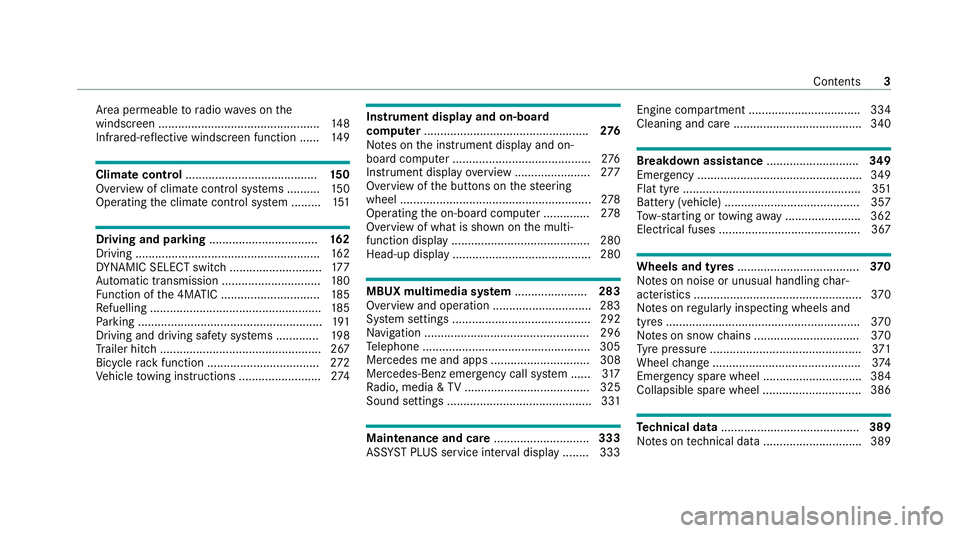
Area pe
rmeable toradio wav es on the
windscreen ................................................ .148
Infrared-reflective windscreen function ...... 14 9Climate control
........................................ 15 0
Overview of climate contro l systems ..........1 50
Operating the climate control sy stem ......... 151 Driving and pa
rking ................................. 16 2
Driving ........................................................ 16 2
DY NA MIC SELECT switch ............................1 77
Au tomatic transmission .............................. 180
Fu nction of the 4MATIC .............................. 185
Re fuelling .................................................... 185
Pa rking ........................................................ 191
Driving and driving sa fety sy stems .............1 98
Tr ailer hit ch................................................. 267
Bicycle rack function .................................. 272
Ve hicle towing instructions ........................ .274 Instrument display and on-board
compu
ter.................................................. 276
No tes on the instrument display and on-
board computer .......................................... 276
Instrument display overview ...................... .277
Overview of the buttons on thesteering
wheel ..........................................................2 78
Operating the on-board computer .............. 278
Overview of what is shown on the multi‐
function display .......................................... 280
Head-up display .......................................... 280 MBUX multimedia sy
stem ...................... 283
Overview and operation .............................. 283
Sy stem settings .......................................... 292
Na vigation .................................................. 296
Te lephone .................................................. .305
Mercedes me and apps .............................. 308
Mercedes-Benz emer gency call sy stem ...... 317
Ra dio, media & TV...................................... 325
Sound settings ............................................ 331 Main
tenance and care ............................. 333
ASS YST PLUS service inter val display ........ 333 Engine compartment .................................. 334
Cleaning and care ......................................
.340 Breakdown assi
stance ............................ 349
Emergency ................................................. .349
Flat tyre ...................................................... 351
Battery (vehicle) ......................................... 357
To w- starting or towing away ....................... 362
Electrical fuses ........................................... 367 Wheels and tyres
..................................... 37 0
No tes on noise or unusual handling char‐
acteristics .................................................. .370
No tes on regular lyinspecting wheels and
tyres .......................................................... .370
No tes on snow chains ................................ 370
Ty re pressure .............................................. 371
Wheel change ............................................ .374
Emergency spare wheel .............................. 384
Collapsible spare wheel .............................. 386 Te
ch nical data .......................................... 389
No tes on tech nical da ta.............................. 389 Contents
3
Page 7 of 525
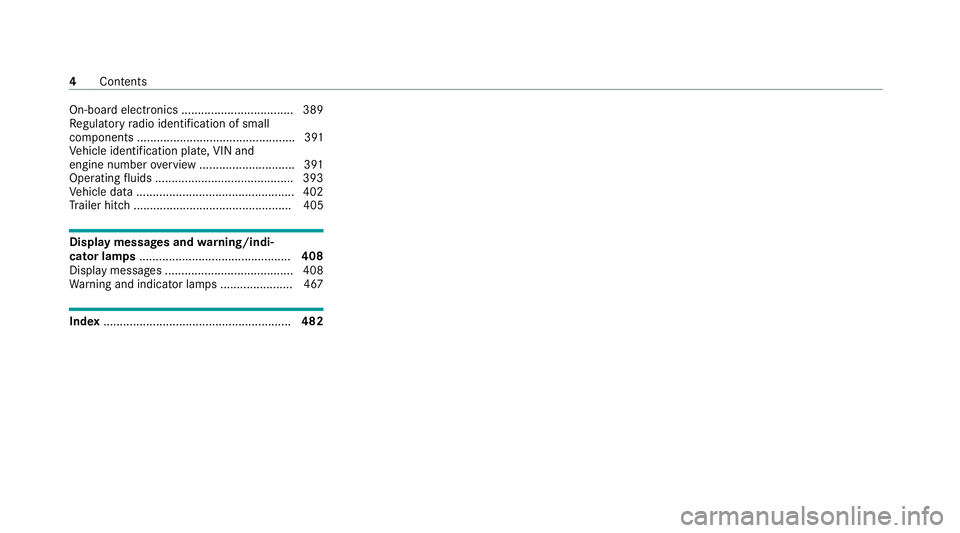
On-board electronics ..................................3
89
Re gulatory radio identification of small
components ................................................ 391
Ve hicle identification plate, VIN and
engine number overview ............................ .391
Operating fluids .......................................... 393
Ve hicle data ................................................ 402
Tr ailer hit ch................................................ 405 Displ
aymessages and warning/indi‐
cator lamps .............................................. 408
Display messages ...................................... .408
Wa rning and indicator lamps ...................... 467 Index
......................................................... 4824
Contents
Page 14 of 525
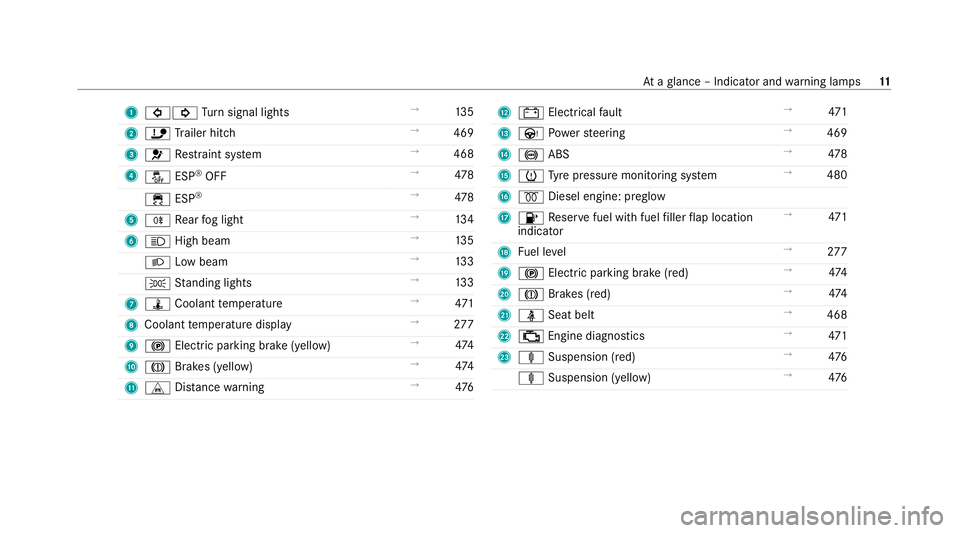
1
003E003D Turn signal lights →
13 5
2 ï Trailer hit ch →
469
3 0075 Restra int sy stem →
468
4 00BB ESP®
OFF →
478
00E5 ESP®
→
478
5 005E Rear fog light →
13 4
6 0057 High beam →
13 5
0058 Low beam →
13 3
0060 Standing lights →
13 3
7 ÿ Coolant temp erature →
471
8 Coolant temp erature display →
277
9 0024 Electric pa rking brake (yellow) →
474
A 004D Brakes (yellow) →
474
B L Distance warning →
476 C
003D Electrical fault →
471
D Ù Powe rst eering →
469
E 0025 ABS →
478
F 0077 Tyre pressure monitoring sy stem →
480
G 0028 Diesel engine: preglow
H 00B6 Reser vefuel with fuel filler flap location
indicator →
471
I Fuel le vel →
277
J 0024 Electric pa rking brake (red) →
474
K 004D Brakes (red) →
474
L 00E9 Seat belt →
468
M 00B9 Engine diagnostics →
471
N ä Suspension (red) →
476
ä Suspension (yellow) →
476 At
aglance – Indicator and warning lamps 11
Page 25 of 525
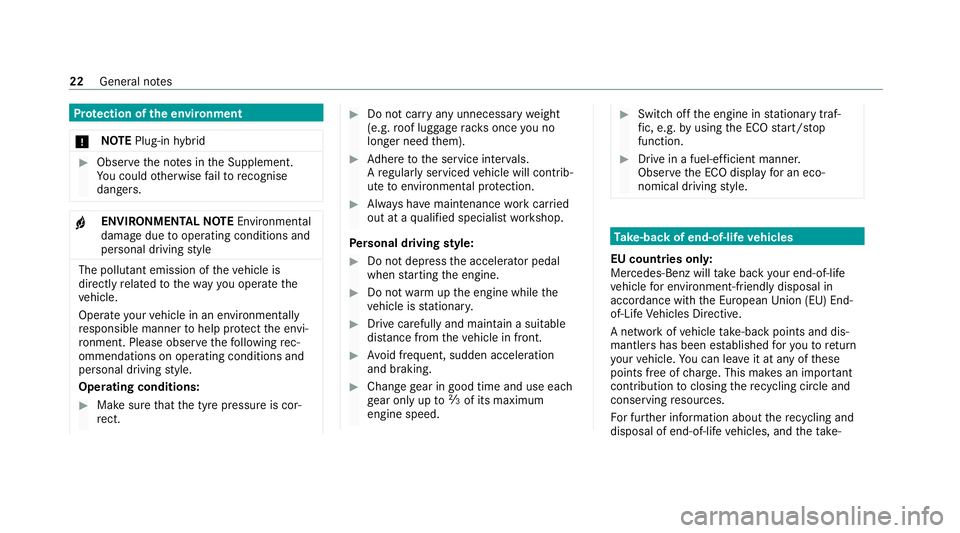
Pr
otection of the environment
* NO
TEPlug-in hybrid #
Obser vethe no tes in the Supplement.
Yo u could otherwise failto recognise
dangers. +
ENVI
RONMENTAL NOTEEnvironmental
dama gedue tooperating conditions and
personal driving style The pollutant emission of
theve hicle is
directly related tothewa yyo u operate the
ve hicle.
Operate your vehicle in an environmentally
re sponsible manner tohelp pr otect the envi‐
ro nment. Please obser vethefo llowing rec‐
ommendations on ope rating conditions and
pe rsonal driving style.
Operating conditions: #
Make sure that the tyre pressure is cor‐
re ct. #
Do not car ryany unnecessary weight
(e.g. roof luggage rack s once you no
lon ger need them). #
Adhere tothe service inter vals.
A regularly serviced vehicle will contri b‐
ute toenvironmen tal pr otection. #
Alw ays ha vemaintenance workcar ried
out at a qualified specialist workshop.
Pe rsonal driving style: #
Do not depress the accelera tor pedal
when starting the engine. #
Do not warm upthe engine while the
ve hicle is stationar y. #
Drive carefully and maintain a suitable
dist ance from theve hicle in front. #
Avoid frequent, sudden acceleration
and braking. #
Change gear in good time and use each
ge ar on lyup to00C3 of its maximum
engine speed. #
Switch off the engine in stationary traf‐
fi c, e.g. byusing the ECO start/ stop
function. #
Drive in a fuel-ef ficient manne r.
Obser vethe ECO display for an eco‐
nomical driving style. Ta
ke -back of end-of-life vehicles
EU countries onl y:
Mercedes-Benz will take back your end-of-life
ve hicle for environment-friendly disposal in
accordance with the European Union(EU) End-
of-Life Vehicles Directive.
A network of vehicle take -ba ckpoints and dis‐
mantlers has been es tablished foryo uto return
yo ur vehicle. You can lea veit at any of these
points free of charge . This makes an impor tant
contribution toclosing there cycling circle and
conse rving resources.
Fo r fur ther information about there cycling and
disposal of end-of-life vehicles, and theta ke- 22
General no tes
Page 34 of 525
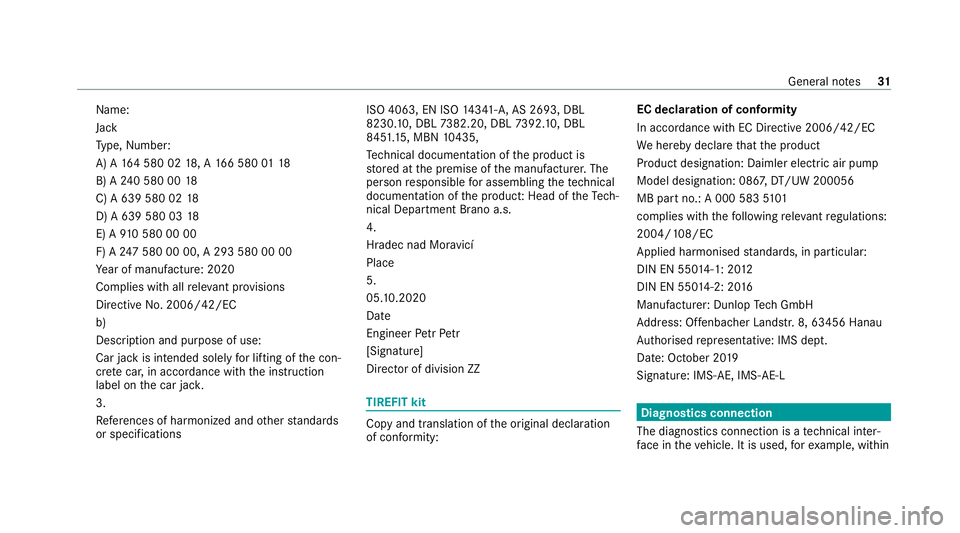
Na
me:
Jack
Ty pe, Number:
A) A 164 580 02 18, A 166 580 0118
B) A 240 580 00 18
C) A 639 580 02 18
D) A 639 580 03 18
E) A 910 580 00 00
F) A 247 580 00 00, A 293 580 00 00
Ye ar of manufacture: 2020
Complies with all releva nt pr ovisions
Directive No. 2006/42/EC
b)
Desc ript ion and purpose of use:
Car jack is intended solely for lifting of the con‐
cr ete car, in accordance with the instruction
label on the car jac k.
3.
Refe rences of harm onized andother standards
or specifications ISO 4063, EN ISO
14341- A,AS 2693, DBL
8230. 10, DBL 7382.20, DBL 7392. 10, DBL
84 51.15, MBN 10435,
Te ch nical documentation of the product is
st ored at the premise of the manufacturer. The
person responsible for assembling thete ch nical
documentation of the product: Head of theTe ch‐
nical Department Brano a.s.
4.
Hradec nad Mor avicí
Place
5.
05. 10.2020
Date
Engineer PetrPe tr
[Signature]
Director of division ZZ TIREFIT kit
Co
py and translation of the original declaration
of confo rmity: EC declaration of conformity
In accordance with EC Directive 2006/42/EC
We
hereby declare that the product
Product designation: Daimler electric air pump
Model designation: 086 7,DT /UW 200056
MB part no.: A 000 583 5101
complies with th efo llowing releva nt regulations:
2004/108/EC
Applied harmonised standards, in particular:
DIN EN 55 014-1: 20 12
DIN EN 550 14-2: 20 16
Manufacturer: Dunlop Tech GmbH
Ad dress: Of fenba cher Landstr. 8, 63456 Hanau
Auth orised representative: IMS dept.
Date: October 20 19
Signatu re: IMS-AE, IMS-AE-L Diagnostics connection
The diagnostics connection is a tech nical inter‐
fa ce in theve hicle. It is used, forex ample, within Gene
ral no tes 31
Page 57 of 525
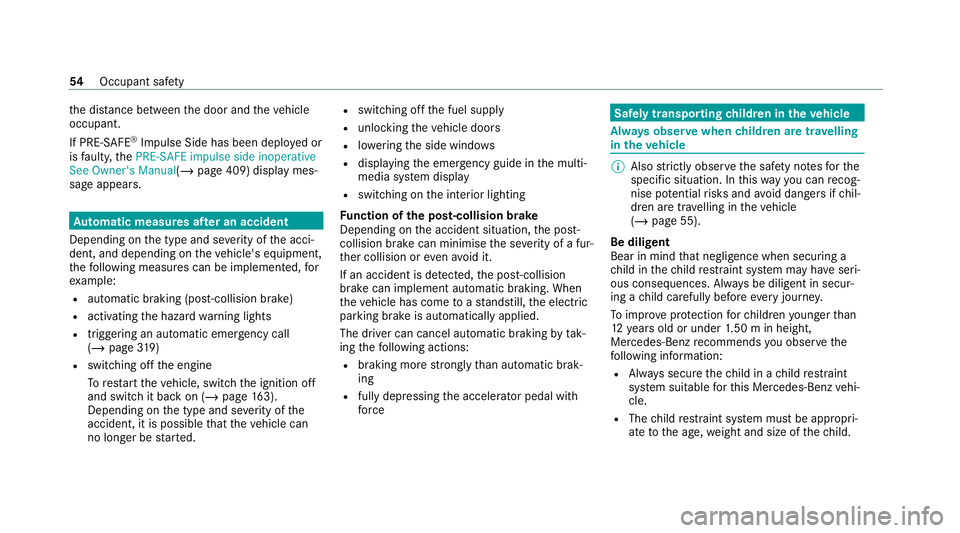
th
e dis tance between the door and theve hicle
occupant.
If PRE-SAFE ®
Impulse Side has been deplo yed or
is faulty, thePRE-SAFE impulse side inoperative
See Owner's Manual( /page 409) display mes‐
sage appears. Au
tomatic measures af ter an accident
Depending on the type and se verity of the acci‐
dent, and depending on theve hicle's equipment,
th efo llowing measures can be implemente d,for
ex ample:
R automatic braking (post-collision brake)
R activating the hazard warning lights
R triggering an automatic emerge ncy call
(/ page 319)
R swit ching off the engine
To restart theve hicle, switch the ignition off
and switch it back on (/ page163).
Depending on the type and se verity of the
accident, it is possible that theve hicle can
no longer be star ted. R
switching off the fuel supply
R unlocking theve hicle doors
R lowe ring the side windo ws
R displaying the emer gency guide in the multi‐
media sy stem display
R switching on the interior lighting
Fu nction of the post-collision brake
Depending on the accident situation, the post-
collision brake can minimise the se verity of a fur‐
th er collision or even avo id it.
If an accident is de tected, the post-collision
brake can implement automatic braking. When
th eve hicle has come toast andstill, the electric
parking brake is automatically applied.
The driver can cancel automatic braking bytak‐
ing thefo llowing actions:
R braking more stronglythan automatic brak‐
ing
R fully depressing the accelera tor pedal with
fo rce Safely transporting
children in theve hicle Alw
ays obser vewhen children are tr avelling
in theve hicle %
Also strictly obser vethe saf ety no tesfo rthe
specific situation. In this wa yyo u can recog‐
nise po tential risks and avoid dangers if chil‐
dren are tr avelling in theve hicle
(/ page 55).
Be diligent
Bear in mind that negligence when securing a
ch ild in thech ild restra int sy stem may ha veseri‐
ous consequences. Alw ays be diligent in secur‐
ing a child carefully before everyjou rney.
To impr oveprotection forch ildren younger than
12 years old or under 1.50 m in height,
Mercedes-Benz recommends you obse rvethe
fo llowing information:
R Alw ays secure thech ild in a child restra int
sy stem suitable forth is Mercedes-Benz vehi‐
cle.
R The child restra int sy stem must be appropri‐
ate tothe age, weight and size of thech ild. 54
Occupant saf ety
Page 86 of 525
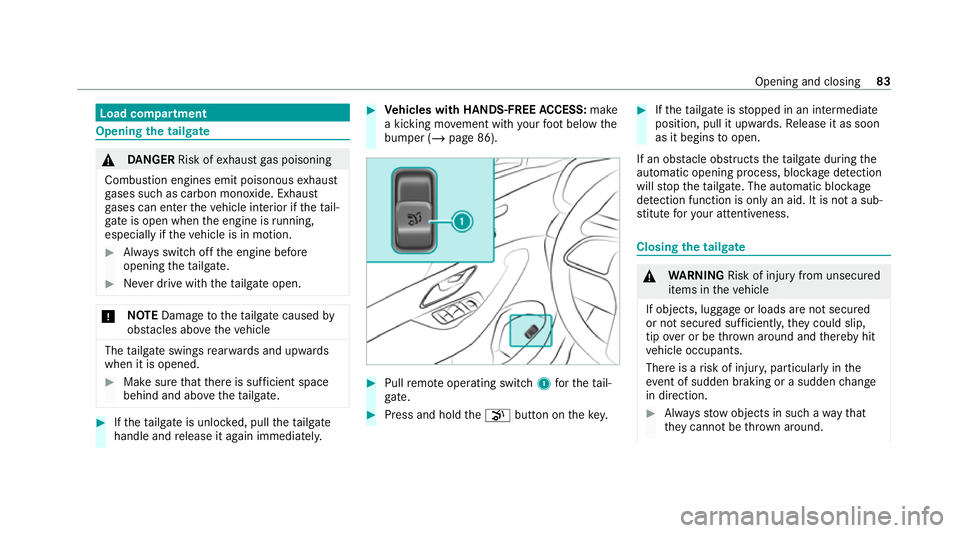
Load compa
rtment Opening the tail
gate &
DANG ER Risk of exhaust gas poisoning
Combustion engines emit poisonous exhaust
ga ses such as carbon monoxide. Exhaust
ga ses can enter theve hicle interior if theta il‐
gate is open when the engine is running,
especially if theve hicle is in motion. #
Alw ays switch off the engine before
opening theta ilgate. #
Never drive with theta ilgate open. *
NO
TEDama getotheta ilgate caused by
obs tacles ab ovetheve hicle The
tailgate swings rear wa rds and upwards
when it is opened. #
Make sure that there is suf ficient space
behind and ab ovetheta ilgate. #
Ifth eta ilgate is unloc ked, pull theta ilgate
handle and release it again immediatel y. #
Vehicles with HANDS-FREE ACCESS: make
a kicking mo vement with your foot below the
bumper (/ page 86). #
Pull remo teoperating switch 1forth eta il‐
ga te. #
Press and hold the008B button on thekey. #
Ifth eta ilgate is stopped in an intermediate
position, pull it upwards. Release it as soon
as it begins toopen.
If an obs tacle obstructs theta ilgate during the
automatic opening process, bloc kage detection
will stop theta ilgate. The automatic bloc kage
de tection function is only an aid. It is not a sub‐
st itute foryo ur attentiveness. Closing
the tailgate &
WARNING Risk of injury from unsecured
items in theve hicle
If objects, luggage or loads are not secured
or not secured suf ficientl y,they could slip,
tip ove r or be throw n around and thereby hit
ve hicle occupants.
There is a risk of injur y,particularly in the
ev ent of sudden braking or a sudden change
in direction. #
Alw aysstow objects in such a wayth at
th ey cannot be thro wn around. Opening and closing
83
Page 102 of 525
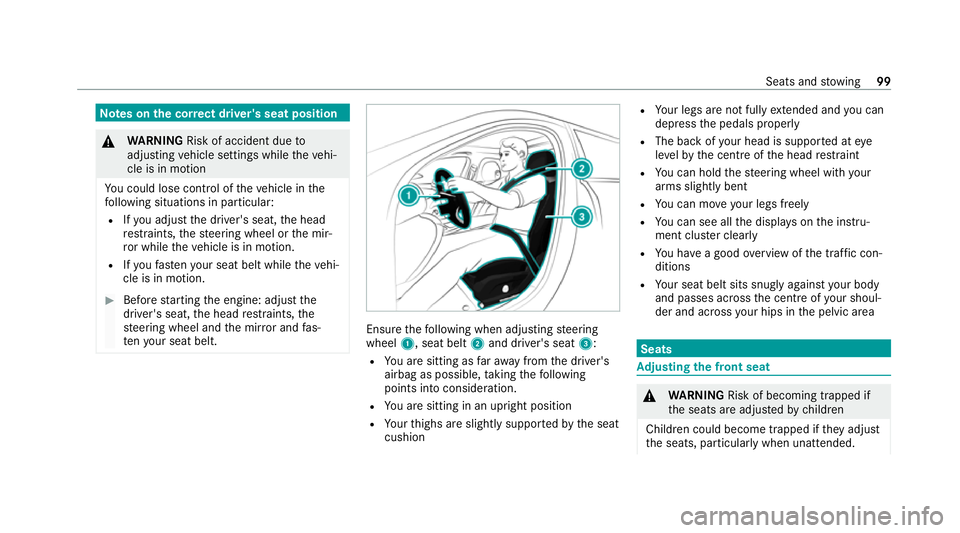
Note
s onthe cor rect driver's seat position &
WARNING Risk of accident due to
adjusting vehicle settings while theve hi‐
cle is in motion
Yo u could lose cont rol of theve hicle in the
fo llowing situations in particular:
R Ifyo u adjust the driver's seat, the head
re stra ints, thesteering wheel or the mir‐
ro r while theve hicle is in motion.
R Ifyo ufast enyour seat belt while theve hi‐
cle is in motion. #
Before starting the engine: adjust the
driver's seat, the head restra ints, the
st eering wheel and the mir ror and fas‐
te nyo ur seat belt. Ensure
thefo llowing when adjusting steering
wheel 1, seat belt 2and driver's seat 3:
R You are sitting as faraw ay from the driver's
airbag as possible, taking thefo llowing
points into consideration.
R You are sitting in an upright position
R Your thighs are slight lysuppor tedby the seat
cushion R
Your legs are not fully extended and you can
depress the pedals properly
R The back of your head is suppo rted at eye
le ve lby the cent reofthe head restra int
R You can hold thesteering wheel with your
arms slightly bent
R You can mo veyour legs freely
R You can see all the displa yson the instru‐
ment clus ter clea rly
R You ha vea good overview of the tra ffic con‐
ditions
R Your seat belt sits snug lyagainst your body
and passes across the cent reofyour shoul‐
der and across your hips in the pelvic area Seats
Ad
justing the front seat &
WARNING Risk of becoming trapped if
th e seats are adjus tedby children
Children could become trapped if they adjust
th e seats, particular lywhen unat tended. Seats and
stowing 99